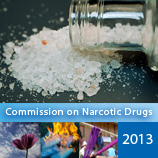 12 March 2013 - In response to a request from last year's session of the Commission on Narcotic Drugs, UNODC has prepared a technical report on the challenges presented by new psychoactive substances (NPS). These substances, sometimes referred to as 'legal highs', are multiplying in numbers and becoming more widespread geographically, causing great concern as officials struggle to contain them.
12 March 2013 - In response to a request from last year's session of the Commission on Narcotic Drugs, UNODC has prepared a technical report on the challenges presented by new psychoactive substances (NPS). These substances, sometimes referred to as 'legal highs', are multiplying in numbers and becoming more widespread geographically, causing great concern as officials struggle to contain them.
The report defines NPS as "substances of abuse, either in a pure form or a preparation, that are not controlled by the 1961 Convention on Narcotic Drugs or the 1971 Convention on Psychotropic Substances, but which may pose a public health threat". In this context, the term 'new' does not necessarily refer to new inventions but to substances that have recently become available.
The use of NPS is often linked to health problems. Users have frequently been hospitalized with severe intoxications. There have also been a number of unexplained suicides with preceding use of synthetic cannabinoids ('spice'). Several other NPS, for example mephedrone and MDPV, have been associated with fatalities.
NPS are currently not under international control, although many countries have established permanent control measures for some NPS or issued temporary bans. Additionally, NPS present a significant challenge for prevention and treatment efforts. More objective and credible information is clearly needed.
To assist countries in the identification of NPS, UNODC plans to establish an Early Warning Advisory capacity. Moreover, as forensic information is essential and laboratories play a key role, UNODC is producing manuals on the identification of synthetic cannabinoids, synthetic cathinones and piperazines which are expected to be published later this year.
The challenge of new psychoactive substances (pdf)
Questions and answers on NPS (pdf)
UNODC Laboratory and Forensic Science Services
UNODC Global SMART Programme (Synthetics Monitoring: Analyses, Reporting and Trends)